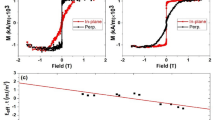Abstract
In the field of spintronics, researchers have manipulated magnetization using spin-polarized currents1,2,3. Another option is to use a voltage-induced symmetry change in a ferromagnetic material to cause changes in magnetization or in magnetic anisotropy4,5,6,7,8,9,10,11,12,13,14. However, a significant improvement in efficiency is needed before this approach can be used in memory devices with ultralow power consumption. Here, we show that a relatively small electric field (less than 100 mV nm−1) can cause a large change (∼40%) in the magnetic anisotropy of a bcc Fe(001)/MgO(001) junction. The effect is tentatively attributed to the change in the relative occupation of 3d orbitals of Fe atoms adjacent to the MgO barrier. Simulations confirm that voltage-controlled magnetization switching in magnetic tunnel junctions is possible using the anisotropy change demonstrated here, which could be of use in the development of low-power logic devices and non-volatile memory cells.
This is a preview of subscription content, access via your institution
Access options
Subscribe to this journal
Receive 12 print issues and online access
$259.00 per year
only $21.58 per issue
Buy this article
- Purchase on Springer Link
- Instant access to full article PDF
Prices may be subject to local taxes which are calculated during checkout




Similar content being viewed by others
References
Slonczewski, J. C. Current-driven excitation of magnetic multilayers. J. Magn. Magn. Mater. 159, L1–L7 (1996).
Berger, L. Emission of spin waves by a magnetic multilayer traversed by a current. Phys. Rev. B 54, 9353–9358 (1996).
Myers, E. B., Ralph, D. C., Katine, J. A., Louie, R. N. & Buhrman, R. A. Current induced switching of domains in magnetic multilayer devices. Science 285, 867–870 (1999).
Nie, X. & Blügel, S. Elektrisches Feld zur Ummagnetisierung eines dünnen Films. European patent 19841034.4 (2000).
Duan, C.-G., Jaswal, S. S. & Tsymbal, E. Y. Predicted magnetoelectric effect in Fe/BaTiO3 multilayers: ferroelectric control of magnetism. Phys. Rev. Lett. 97, 047201 (2006).
Rondinelli, J. M., Stengel, M. & Spaldin, N. Carrier-mediated magnetoelectricity in complex oxide heterostructures. Nature Nanotech. 3, 46–50 (2008).
Weisheit, M. et al. Electric field-induced modification of magnetism in thin-film ferromagnets. Science 315, 349–351 (2007).
Chiba, D., Yamanouchi, M., Matsukura, F. & Ohno, H. Electrical manipulation of magnetization reversal in a ferromagnetic semiconductor. Science 301, 943–945 (2003).
Stolichnov, I. et al. Non-volatile ferroelectric control of ferromagnetism in (Ga,Mn)As. Nature Mater. 7, 464–467 (2008).
Borisov, P., Hochstrat, A., Chen, X., Kleemann, W. & Binek, C. Magnetoelectric switching of exchange bias. Phys. Rev. Lett. 94, 117203 (2005).
Chen, X., Hochstrat, A., Borisov, P. & Kleeman, W. Magnetoelectric exchange bias systems in spintronics. Appl. Phys. Lett. 89, 202508 (2006).
Chu, Y. H. et al. Electric-field control of local ferromagnetism using a magnetoelectric multiferroic. Nature Mater. 7, 478–482 (2008).
Eerenstein, W., Mathur, N. D. & Scott, J. F. Multiferroic and magnetoelectric materials. Nature 442, 759–765 (2006).
Novosad, V. et al. Novel magnetostrictive memory device. J. Appl. Phys. 87, 6400–6402 (2000).
Néel, L. Anisotropie magnétique superfigielle et surstructures d'orientation. J. Phys. Rad. 15, 225–239 (1954).
Gradmann, U. Ferromagnetism near surfaces and in thin films. Appl. Phys. 3, 161–178 (1974).
Shinjo, T., Hine, S. & Takada, T. Mössbauer spectra of ultrathin Fe films coated by MgO. Journal de Physique 40, C2-86–87 (1979).
Carcia, P. F., Meinhaldt, A. D. & Suna, A. Perpendicular magnetic anisotropy in Pd/Co thin film layered structure. Appl. Phys. Lett. 47, 178–180 (1985).
Gay, J. G. & Richter, R. Spin anisotropy of ferromagnetic films. Phys. Rev. Lett. 56, 2728–2731 (1986).
Liu, C. & Bader, S. D. Perpendicular surface magnetic anisotropy in ultrathin epitaxial Fe films. J. Vac. Sci. Technol. A 8, 2727–2731 (1990).
Suzuki, Y., Katayama, T., Yoshida, S. & Tanaka, K. New magneto-optical transition in ultrathin Fe(100) films. Phys. Rev. Lett. 68, 3355–3358 (1992).
Yuasa, S., Nagahama, T., Fukushima, A., Suzuki, Y. & Ando, K. Giant room-temperature magnetoresistance in single-crystal Fe/MgO/Fe magnetic tunnel junctions. Nature Mater. 3, 868–871 (2004).
Heinrich, B., Celinski, Z., Cochran, J. F., Arott, A. S. & Myrtle, K. Magnetic anisotropies in single and multilayered structures. J. Appl. Phys. 70, 5769–5774 (1991).
Bland, J. A. C. & Heinrich, B. (eds) Ultrathin Magnetic Structures Part I, 65–90 (Springer, 1994).
Kyuno, K., Ha, J. G., Yamamoto, R. & Asano, S. First-principle calculation of the magnetic anisotropy energies of Ag/Fe(001) and Au/Fe(001) multilayers. J. Phys. Soc. Jpn 65, 1334–1339 (1996).
Shick, A. B., Máca, F., Mašek, J. & Jungwirth, T. Prospect for room temperature tunneling anisotropic magnetoresistance effect: Density of states anisotropies in Cp/Pt system. Phys. Rev. B 73, 024418 (2006).
Moser, J. et al. Tunneling anisotropic magnetoresistance and spin–orbit coupling in Fe/GaAs/Au tunnel junctions. Phys. Rev. Lett. 99, 056601 (2007).
Gao, L. et al. Bias voltage dependence of tunneling anisotropic magnetoresistance in magnetic tunnel junctions with MgO and Al2O3 tunnel barriers. Phys. Rev. Lett. 99, 226602 (2007).
Park, B. G. et al. Tunneling anisotropic magnetoresistance in multilayer-(Co/Pt)/AlOx/Pt structures. Phys. Rev. Lett. 100, 087204 (2008).
Moog, E. R., Liu, C., Bader, S. D. & Zak, J. Thickness and polarization dependence of the magnetooptic signal from ultrathin ferromagnetic films. Phys. Rev. B 39, 6949–6956 (1989).
Acknowledgements
The authors would like to thank D. Yamaguchi, Y. Sobajima, T. Toyama and H. Okamoto for their assistance in ITO deposition. The authors also acknowledge H. Kubota, W. Van Roy, S. Blügel and T. Miyazaki for their valuable comments. A part of the research was conducted under the financial support of Grant-in-Aid for Scientific Research (A19206002) and G-COE program of Ministry of Education, Culture, Sports, Science and Technology-Japan (MEXT).
Author information
Authors and Affiliations
Contributions
Y.S. conceived and designed the experiments and performed micro magnetic calculation. T.M. and Y.S. performed the experiments and analysis. T.N. and A.A.T. led experiments and physical discussions. K.O., N.T. and M.M. established experimental techniques. S.M. and Y.A. performed FMR measurements. M.S. and T.S. contributed to general discussions. T.M. wrote the paper with review and input from Y.S., T.N. and A.A.T.
Corresponding author
Supplementary information
Supplementary Information
Supplementary Information (PDF 478 kb)
Rights and permissions
About this article
Cite this article
Maruyama, T., Shiota, Y., Nozaki, T. et al. Large voltage-induced magnetic anisotropy change in a few atomic layers of iron. Nature Nanotech 4, 158–161 (2009). https://doi.org/10.1038/nnano.2008.406
Received:
Accepted:
Published:
Issue Date:
DOI: https://doi.org/10.1038/nnano.2008.406
This article is cited by
-
Giant gate modulation of antiferromagnetic spin reversal by the magnetoelectric effect
NPG Asia Materials (2024)
-
Skin-effect-mediated magnetoionic control of charge transport in thick layers
Scientific Reports (2024)
-
Bifurcation to complex dynamics in largely modulated voltage-controlled parametric oscillator
Scientific Reports (2024)
-
Strain-induced specific orbital control in a Heusler alloy-based interfacial multiferroics
NPG Asia Materials (2024)
-
Spintronic virtual neural network by a voltage controlled ferromagnet for associative memory
Scientific Reports (2024)



